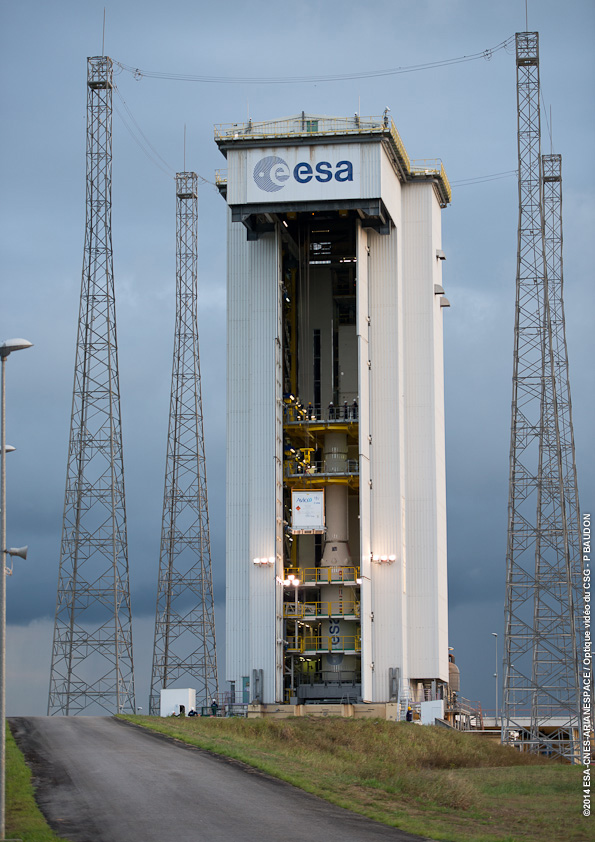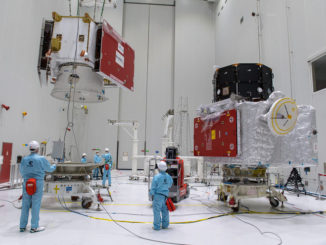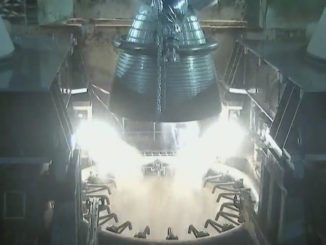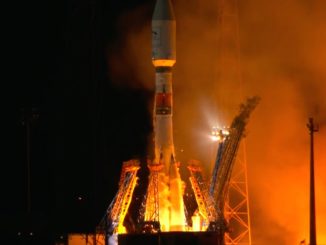
Engineers are resuming preparations to launch an experimental European re-entry test vehicle on a Vega rocket Feb. 11 after a two-month delay ordered by safety authorities to analyze risks posed to the public by the booster’s unique trajectory after liftoff from French Guiana.
The safety review ordered by CNES — the French space agency — prompted a delay in the launch of the Intermediate Experimental Vehicle from Nov. 18 to Feb. 11. CNES is responsible for the safety of the public and infrastructure at the Guiana Space Center, Europe’s spaceport located on the northeast coast of South America.
The launch trajectory of the IXV space plane on a suborbital trajectory will differ from the Vega rocket’s previous flights, which flew north from the space center with satellites heading for high-inclination polar orbits. The launch of IXV will head east from Vega’s launch pad, and the geometry of the French Guiana coastline means it will fly over land in the first phase of the launch sequence.
Officials said they slightly adjusted the launch track to alleviate the safety concern.
The four-stage Vega rocket was stacked on the launch pad at the Guiana Space Center, and the IXV spacecraft was about to be fueled with hydrazine maneuvering propellant when officials announced the delay in October.
A ship tasked with retrieving the space plane after splashdown in the Pacific Ocean had already left port in Italy when news of the launch delay was released.
Giorgio Tumino, IXV’s program manager at the European Space Agency, told Spaceflight Now that technicians will load hydrazine into the space plane the week of Jan. 19. By the end of January, the 2,000-kilogram (4,409-pound) spacecraft will be mated to the Vega rocket’s payload attachment adapter and enclosed within the launcher’s nose fairing.
Workers will transfer the IXV space plane — inside the payload fairing — to the Vega rocket’s launch facility, where the composite will be hoisted atop the booster for final testing in early February.
Liftoff on Feb. 11 is set for a two-hour launch window opening at 1300 GMT (8 a.m. EST), Tumino said.

The IXV space plane and Vega launcher programs are managed by ESA under Italian leadership. Thales Alenia Space built the car-size spacecraft.
The Intermediate Experimental Vehicle will launch on an arcing suborbital path reaching a top speed of 7.5 kilometers per second, or nearly 16,800 mph, and a peak altitude of 420 kilometers (261 miles). Its flight will last 100 minutes before splashdown in the Pacific Ocean, where the Italian ship Nos Aries will recover the space plane for return to Europe for inspections of its heat shield, structure and internal components.
Small rocket thrusters and two aft-mounted aerodynamic flaps will control the spacecraft’s descent. It will plunge back into the atmosphere at an altitude of 120 kilometers (74 miles) on a path engineers say is similar to a re-entry trajectory from low Earth orbit.
The IXV will deploy parachutes to slow it down before landing.
The guided re-entry experiment will help engineers design future re-entry vehicles that could be used in exploration, microgravity research, Earth observation, and orbital debris mitigation, according to ESA.
“This is the first flight demonstration of features such as highly advanced thermal structures: thrusters and flaps that are part of the control system, and the 300 sensors and infrared camera to map the heating all along the spacecraft from the nose to the flaps,” said Jose Longo, head of ESA’s aerothermodynamics department. “These things just cannot be tested in the same way in laboratories.”
The IXV testbed arrived at the spaceport in Kourou, French Guiana, on Sept. 24 after a trans-Atlantic flight aboard a Russian Antonov cargo plane.
The Vega rocket’s assembly on its launch mount began Sept. 18 with the stacking of the booster’s solid-fueled P80 first stage motor. After the addition of Vega’s solid-fueled second and third stages, the rocket’s Ukrainian-built hydrazine-burning fourth stage was added in mid-October to complete the launcher’s build-up.
When the IXV and payload shroud are added, the Vega rocket will stand 98 feet tall.
Follow Stephen Clark on Twitter: @StephenClark1.



